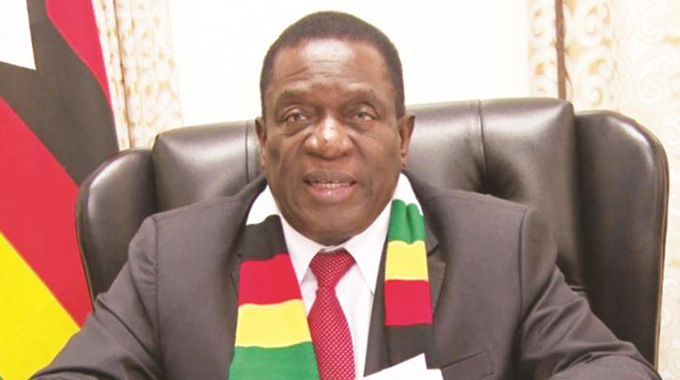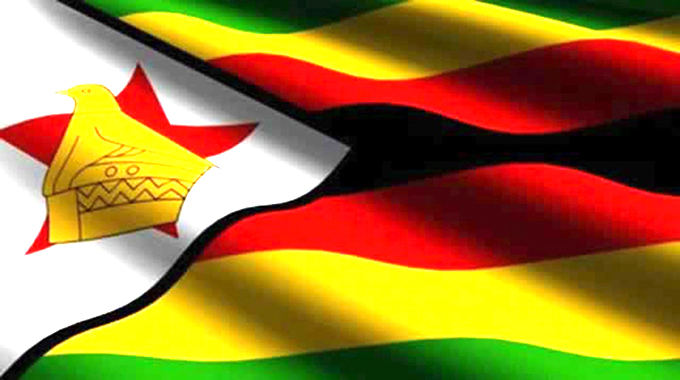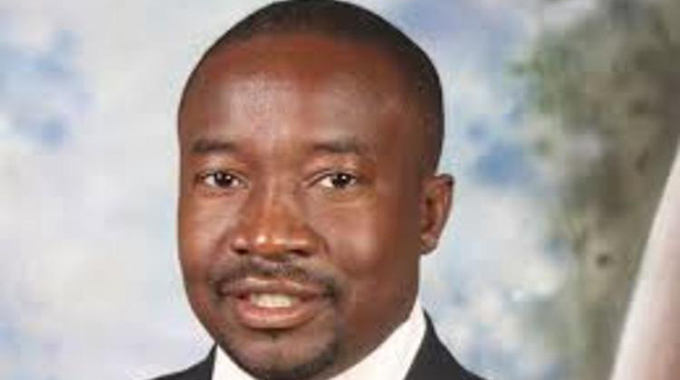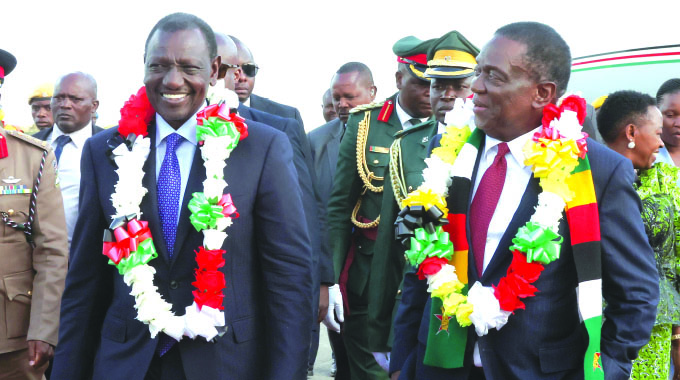Three years on: Second Republic marches to prosperity

Elliot Ziwira
Senior Reporter
Since coming to power in November 2017, the Second Republic under President Mnangagwa has made strides in job creation, re-engagement, democracy, curbing corruption, conflict resolution and agricultural productivity, among other achievements aimed at fostering socio-economic development and peaceful co-existence to eradicate poverty.
In his inauguration speech on November 24, 2017, President Mnangagwa — the servant leader — highlighted that unity and peace was paramount in achieving economic development.
In his own words, the President said: “Fellow Zimbabweans, as we chart our way forward, we must accept
that our challenges as a nation emanate in part from the manner in which we have managed our politics, both nationally and internationally, leading to circumstances in which our country has undeservedly been perceived or classified as a pariah State.”
Affirming his seriousness in the fight against corruption, as outlined in his inauguration speech in 2017, President Mnangagwa fired then Health and Child Care Minister Dr Obadiah Moyo on July 7, 2020.
Moyo is facing charges of corruption and criminal abuse of office over his role in the murky US$60 million deal with medical supplier Drax International.
He became the second minister to be sacked from the current Cabinet following the dismissal of former Public Service, Labour and Social Welfare Minister Prisca Mupfumira in August 2019 on similar grounds.
Both Moyo and Mupfumira are on bail awaiting trial.
The President underscored that the envisaged new Zimbabwe buttressed by servant leadership where corruption and unnecessary bureaucracy would be a thing of the past, was within reach, although it could not be achieved overnight.
“It will not be easy, but as the Holy Bible teaches us: ‘For you have need of endurance, so that when you have done the will of God, you may receive what was promised,’” said the President.
Notwithstanding the illegal economic sanctions imposed on the country by some Western countries, the Second Republic crafted people-oriented five-year blueprints premised on national frameworks meant to better citizens’ livelihoods.
On Monday, the President launched the National Development Strategy 1 (NDS1); an economic master plan focusing on inclusive development from 2021 and 2025.
Pivoted on yet another strategic participatory governance plan earmarked at curtailing resource-based conflict areas; devolution, NDS1 endeavours to streamline gender, youth women and other vulnerable groups, thus creating equal opportunities for all in an economically stable environment.
NDS1 is a successor step to the Transitional Stabilisation Programme (TSP) in the drive to achieve a middle income economy by 2030 as enshrined in national Vision 2030. The TSP, a fiscal and monetary reform, which has brought the much needed economic stability the country enjoys and leverages its growth trajectories on, was launched in October 2018, and will run till the end of the year.
Devolution
Devolution is another milestone achieved in the past three years as Zimbabwe looks into the future with the Government launching the “Devolution and Decentralisation Policy” this year, to spell out the constitutional requirements and strategies for implementation frameworks across the country’s 10 provinces.
The Second Republic has committed to the implementation of the programme through Treasury’s disbursement of $703 million allocated to 92 local authorities in the 2019 National Budget under intergovernmental transfers. Government has committed $2,9 billion to accelerate programme implementation in 2020.
The funds were earmarked for capital projects that benefit citizens in the following service areas: schools and clinics, roads, plant and equipment, water, sewer and solid waste management, electricity and any other capital activities that may be deemed necessary for service provision.
The philosophy behind devolution is to eliminate marginalisation by decentralising power to provincial and metropolitan councils. In many areas countrywide water and sanitation issues are being addressed, schools and medical facilities are being constructed, road rehabilitation programmes are also ongoing to complement existing Government programmes.
Local authorities are utilising the funds to implement their projects.
Conflict resolution
Under President Mnangagwa, the Second Republic has taken a bold step towards addressing conflict through the signing of the National Peace and Reconciliation Commission Act on January 5, 2018.
This paved the way for dialogue towards sustainable peace and peaceful co-existence.
Peace is the yardstick of political stability, and is key to socio-economic development, because without peace politics becomes a meaningless endeavour, and the economy is deemed non-existent.
The Second Republic had inherited conflict issues, such as the emotive Gukurahundi, which had continued to deny the nation peaceful co-existence over the past three decades.
The NPRC has been playing its role as mandated by the Constitution, to unite Zimbabwe for sustainable peace by developing mechanisms for resolving violent conflicts of the past and present and preventing their recurrence.
Under the leadership of President Mnangagwa, the Second Republic had made re-engagement one of its key priorities and had established a platform for dialogue with political parties, churches and civil society organisations, to put closure to past conflicts, particularly the Gukurahundi issue.
The issuance of birth and death certificates for Gukurahundi victims had also been given priority through legislative input.
In February this year, the NPRC started a training programme for provincial peace committees as part of its constitutional mandate.
The committees were set up last year, with every commissioner superintending a committee of between 25 and 30 members.
Democracy
The Second Republic opened up spaces for constructive dialogue aimed at thwarting politics of negativity. Political negativity feeds into politics of subterfuge, where Western ideologies are advanced at the expense of the national interest.
Regarding President Mnangagwa’s commitment to constructive dialogue through POLAD, Bethel Christian Party leader Dr Willard Tawonezvi Mugadza said: “Under the Second Republic, we have an opportunity, as opposition political parties, to move away from Western type opposition ideology that is meant to create negative political energy in the country.
“We must, as opposition political parties, create an environment where the Government is willing to engage constructively and respectfully with us. That way, our suggestions on issues of nation-building can be considered favourably.”
The Constitutional Court notched a number of milestones since its establishment, chief among them being the superior court’s sitting in August 2018 to consider submissions by MDC-Alliance presidential contestant Nelson Chamisa in challenge to his loss to President Mnangagwa in the July 30, 2018 harmonised elections.
The challenge marked a new trajectory in Zimbabwean politics in as far as opening up of political space is concerned.
That Chamisa enjoyed the freedom to reduce the majority vote of the citizens of Zimbabwe to a Constitutional Court Bench vote, in the full glare of global lenses is testimony to President Mnangagwa’s commitment to the rebuilding of the great nation of Zimbabwe.
Like any other Zimbabwean, Chamisa exercised his constitutional right to refuse defeat so that justice could be the ultimate winner.
With the court of public opinion in situ, the Bench led by Chief Justice Luke Malaba, carried the day for its learned and sober interpretation of facts to put to rest a nation’s anxiety, and refashion aspirations for that Golden Future Time Zimbabweans have all been yearning for.
Re-engagement efforts
Like any other country, Zimbabwe’s foreign policy endeavours to advance the country’s policy objectives on the global arena. Alive to the fact that national interests are the fulcrum of any country’s foreign policy as they drive its conception, Zimbabwe’s (foreign policy) is an extension of its domestic policy.
The Second Republic advocates engagement and re-engagement as a way of pushing for outcomes where the common good is the ultimate winner.
In 2018, Zimbabwe’s premier investment promotion body, Zimbabwe Investment Authority (ZIA), revealed that it received 165 business applications worth US$15,8 billion between January and June of the same year.
In April 2018, President Mnangagwa led a delegation of 10 Cabinet ministers and about 80 business executives to China, as the new administration angled for opportunities in an effort to buttress ways to turnaround the economy, which has been under stress for the past two decades or so.
The President outlined his noble intentions then when he said: “The issue is not only about attracting capital into Zimbabwe. It’s an issue of leapfrogging after 18 years of isolation so that we catch up with the rest of the developing countries.”
The reciprocal visit by a delegation of 60 Chinese government officials and private business executives to Harare in June 2018, led by the Secretary of Zhejiang Provincial Committee of the Communist Party of China (CPC) and Chairman of the standing committee of Zhejiang’s Provincial People’s Congress Mr Che Jun, ahead of the Zimbabwe-China Forum, to scout for business opportunities, was a huge step towards win-win outcomes.
In March 2019, the two principals to the Third Session of the Zimbabwe-South Africa Bi-National Commission Summit held in Harare, President Mnangagwa and his counterpart President Cyril Ramaphosa, signed an agreement to accelerate implementation of 45 Memoranda of Understanding (MOUs) cutting across various sectors of the economy,
From April 29, 1994, bilateral relations between the two countries took a new dimension meant to push forward the aspirations of the peoples of Zimbabwe and South Africa through fostering win-win outcomes.
Beyond sharing geographical proximity, Zimbabwe and South Africa are top trading partners.
According to the Zimbabwe National Statistics Agency (Zimstats), Zimbabwe imported goods worth $6,3 billion between February and December 2018, up from $4,9 billion in the prior year. During the same period the country’s exports stood at $3,9 billion, leaving a trade deficit of $2,4 billion.
A trade deficit of such a magnitude, however, needs to be worked on. Also, the nature of exports exposes another challenge; the exports are mostly unprocessed raw materials. There is an urgent need for beneficiation across all sectors.
With the country angling for a middle income economy by 2030 supported by the economic blueprint, Transitional Stabilisation Programme (TSP), the implementation of 45 agreements between Zimbabwe and South Africa in existence on paper for some time, will not only add value to the country’s exports, but will revive the manufacturing, mining and agricultural sectors, among others.
Job creation, revamping of industry
In 2018 President Mnangagwa commissioned a US$30 million state-of-the-art bottling plant at Varun Beverages Zimbabwe’s premises in Harare. The second phase of the manufacturing plant was officially opened in December 2019 at a cost of US$20 million.
The additional lines to the plant considerably increased production levels. Varun Beverages, the largest bottler of PepsiCo products — Pepsi, Mirinda, Mountain Dew and Seven-Up outside the United States of America, employs over 1 000 people, and has empowered 1 500 women through allocation of vending trolleys.
About 20 000 retailers and vendors have access to Pepsi products across the country, and close to 22 000 families benefit directly or indirectly from the company.
Another major investment that came to the benefit of Zimbabweans in the past two years is the US$120 million tile manufacturing plant in Norton.
Sunny Yi Feng Tiles (Zimbabwe) opened its production lines in May, 2019.
The company operates three factories that make tiles, print cardboard boxes for packaging them and offer logistical support. With an installed capacity of 35 000 square metres of tiles per day, Sunny Yi Feng employs 1 000 people — 800 Zimbabwean citizens and 200 Chinese nationals. A further 600 jobs will be created when full capacity is reached.
Another indicator that Zimbabwe was a destination of choice to investors was resplendent at the 60th edition of the Zimbabwe International Trade Fair (ZITF), which ran under the theme “Propagating Industrial Growth through Trade and Investment” in 2019, when space was sold out for the first time since inception in 1959 forcing organisers to pitch up tents.
The space available for sale rose from 47 612 square metres in 2016 to 57 732 square metres in 2019.
Inroads have also been made towards beneficiation of horticultural products through Government support to companies in that sector, and the resuscitation of the national herd.
Chinhoyi University of Technology launched an Artificial Insemination Programme that can yield US$140 million, which can go a long way in growing the national herd, empowering farmers and boosting the country’s foreign currency coffers.
In Zimbabwe, the artisanal and small-scale mining sector has been a major contributor to the total gold output, hence, the Second Republic’s efforts to rope the sector in to curb stigmatisation.
According to Fidelity Printers and Refiners, the sector accounted for 22 of the 34 tonnes of gold produced in 2018, representing a 65 percent contribution. Gold exports contributed US$1,33 billion in the same year.
To attract foreign direct investment, the Government relaxed shareholding regulations for mining operations. Foreign investors are now allowed to own 100 percent shareholding in all mineral ventures except for platinum and diamonds.
In joint ventures for diamond and platinum mining the Government is entitled to 51 percent while the foreign investor would get 49 percent shareholding.
The US$4,2 Karo Resources project officially launched by President Mnangagwa in 2018 is another milestone to celebrate. The consolidated platinum project in Mhondoro-Mubaira is set to create a combined 90 000 jobs.
The first 15 000 jobs will come directly from employment by Karo Resources, while 75 000 will be created through secondary and tertiary industries when the project reaches its peak by 2023.
The investor will also establish a power plant with a 600 megawatt capacity, enough to drive the mine and contribute the surplus to the national grid.
The ministry also made strides towards the resuscitation of Delta Gold’s Eureka Mine in Guruve which is expected to attain its production target of two tonnes of gold by 2021, after President Mnangagwa re-commissioned the mine in 2018.
In line with the national Vision 2030, the country targets to hit 100-tonne gold production by 2023, and achieve its mission to have a stable and sustainable US$12 billion mining industry by the same year.
In addition the multi-billion Arcadia Lithium Project, launched by the President in 2019, and expected to go into production within 18 months will also go a long way in creating employment opportunities for Zimbabweans and grow the economy.
In January 2020, Great Dyke Investments began mining on its Darwendale concessions after years of preparation.
The US$2 billion project is a joint venture between Russia’s Vi Holdings and Zimbabwe’s Landela Mining Venture Pvt Ltd.
The US$1,1 billion Hwange venture is the largest project under the milestone deals signed between Zimbabwe and China, and is expected to feed 600 megawatts into the national grid — easing the country’s power challenges.
The main contractor executing the Hwange 7 and 8 power expansion, Sinohydro indicates the project is 40 percent complete.
The project has provided employment for 1 812 locals.
The Zimbabwe Consolidated Diamond Company is projected to increase production to 10 million carats worth about US$1 billion by 2023.
Zimbabwe is rich in minerals, some of which are: gold, silver, platinum group metals (PGMs) consisting of platinum, palladium, rhodium, ruthenium, iridium and osmium; diamonds, chrome, coal, nickel, asbestos, coal bed methane, copper, iron, pegmatite (tantalite, tin and wolframite, beryl, mica, feldspar, gemstones such as emerald, aquamarine, chrysoberyl, alexandrite and euclase), and dimension stones (Granites, gneisses, migmatites, gabbro-norites, dolerite, marbles and quartzites).
The country has the second largest high grade chromium ores in the world after South Africa, with reserves of approximately 10 billion tonnes.
Strides have also been made towards capacitation of the fertiliser manufacturing sector.
The Government has adopted the Five Year Fertiliser Import Substitution with nearly US$80 million having been invested to capacitate local firms; Sable Chemicals and Chemplex Phosphates. The development would see prices of ammonium nitrate fertiliser declining by an average 28 percent over the next four years, from the current US$25 per 50kg bag to US$18, the price of phosphates is expected to drop to US$9,25 from US$13.
In a normal farming season, the country requires about 600 000 tonnes (both basal and top dressing), with 70 percent going towards Government farming programmes like Pfumvudza.
Through an investment of nearly US$40 million Sable Chemicals’ output is set to increase to 240 000 tonnes of AN by 2024, thus reducing imports from 220 000 to 10 000 tonnes.
Chemplex’s subsidiaries — ZimPhos and Dorowa Mines would be capitalised to the tune of US$36 million. It is envisaged that phosphates production would be boosted to 100 000 tonnes from 80 000 tonnes with imports coming down to 140 000 from 180 000 tonnes.
Agricultural productivity
Conscious of the significance of the land in fostering identity and empowering citizens, the President declared in his inauguration speech on November 24, 2017: “However, given our historical realities, we wish the rest of the world to understand and appreciate that policies and programmes related to land reform were inevitable.
“While there is a lot we may need to do by way of outcomes, the principle of repossessing our land cannot be challenged or reversed.
“Dispossession of our ancestral land was the fundamental reason for waging the liberation struggle.
“It would be a betrayal of the brave men and women, who sacrificed their lives in our liberation struggle if we were to reverse the gains we have made in reclaiming our land.”
Therefore, although concessions were made under the Global Compensation Deed agreement between the Government and white former farmers, whose land was expropriated under the country’s land reform programme, compensation was for improvements, biological assets and land clearing costs, as spelt out in the Constitution of Zimbabwe, and not for the land.
With 365 000 hectares of total arable land in Zimbabwe suitable for irrigation, the need arises to invest in irrigation schemes.
In March, 2020, President Mnangagwa commissioned Nyakomba Irrigation Scheme in Nyanga.
The US$15 million project which commenced in 2015 was funded under the Japanese Grant Aid.
The Ministry of Lands, Agriculture, Water and Rural Resettlement’s Department of Irrigation and the Japan International Cooperation Agency (JICA) were involved in the rehabilitation and development of the facility.
A modernised agriculture sector will bring national Vision 2030 to citizens’ doorsteps.
Mindful of the need to move away from over-reliance on rain-fed farming so as to ascertain food self-sustenance, the President commissioned the multi-million dollar Marovanyati Dam in Buhera on November 10, 2020. The dam is expected to provide water for domestic, agricultural and industrial use. Investment in strategic water bodies is the way to go in turning around the fortunes of the country through freeing up resources for capital schemes.
Marovanyati Dam provides water to Murambinda Irrigation Scheme and Murambinda Growth Point. It is expected to supply two more irrigation projects that are being developed.
Dorowa Mine and other smaller industries are already benefiting from the dam.
The dam, which is on the Mwerihari River, has a storage capacity of 50 million cubic metres. The perennial river has an annual flow of 182 million cubic metres, and is anticipated to increase to 600 megalitres by 2030.
In May this year, the President launched the Presidential Livestock Scheme at Cleveland Range in Harare to support livestock farmers.
This comes at a time the Government is making efforts to grow the livestock sub-sector, which contributes up to 18 percent of the Gross Domestic Product. The sub-sector has been burdened by macroeconomic challenges and diseases such as tuta absoluta and theileriosis (January disease) in cattle.
In June 2018, President Mnangagwa launched the Command Livestock programme at Gwanda Showground, to cater mainly for Matabeleland, where he handed over 1 660 heifers to 151 beneficiaries from Matabeleland South’s seven districts with $10 million being channelled towards the scheme to empower communities in Matabeleland North and South by boosting their herds.
Further, production of fruit, vegetables and other horticulture products for export are to be revived and the sector expanded with major investment from the private sector and the Government under the Horticulture Recovery and Growth Plan drafted by the Ministry of Lands, Agriculture, Water and Rural Resettlement.
This dovetails with the national Vision 2030, through transformation of agriculture from a US$5,2 billion to US$8 billion sector.
As envisaged, the horticulture recovery and growth plan will not just boost exports, but also drive rural incomes, adding US$2 000 to the average household income for participating small-scale farmers by 2030.
The recovery plan would require US$1 billion from the private sector and partners while the Presidential Horticulture Scheme, would benefit 1,8 million rural households at a cost of US$186 million.
Early this year, the Government introduced Pfumvudza, a farming concept that maximises productivity per unit area, to mitigate against impacts of climate change, to ensure food and nutritional security at the household and national levels.
About 1,6 million households on the Presidential Inputs Scheme and A1 farmers are using the concept for household food security, while A2 farmers are expected to produce for the Strategic Grain Reserve.
According to the Ministry of Lands, Agriculture, Water and Rural Resettlement’s “National Agriculture Policy (2018-2030): First Draft” (2018) report, the reduction of large-scale commercial farms benefited 145 000 new A1 farmers, 18 000 new A2 farmers by 2018, bringing the total number of smallholder farmers to approximately 1,3 million.
The report reveals that the number of large-scale farmers came down from 6 000 to 4 500. Over a million communal farmers rely on rain-fed agriculture, with 70 percent of them sustaining livelihoods on less than two hectares.
Agriculture remains a key component in Zimbabwe’s economic development matrix as it creates employment and reduces poverty. The report indicates that agriculture contributes 15-18 percent of Gross Domestic Product (GDP), 23 percent to total formal employment, and offers livelihoods to close to 70 percent rural citizens (54 percent of them women).
About 63 percent of industrial raw materials, and 60 percent of manufacturing value addition come from agriculture. In export earnings, agriculture enjoys a 30 percent share. Of the 31 industry clusters in Zimbabwe, 15 rely on agriculture for feedstock. In addition, a third of the formal labour force is supported by agriculture-related employment.
Beef and fisheries provide 10 percent, and 24 percent comes from sheep, goats, pigs, poultry and ostrich. Tobacco, cotton, sugar, horticulture, tea and bananas jointly account for 40 percent of national exports value.









Comments